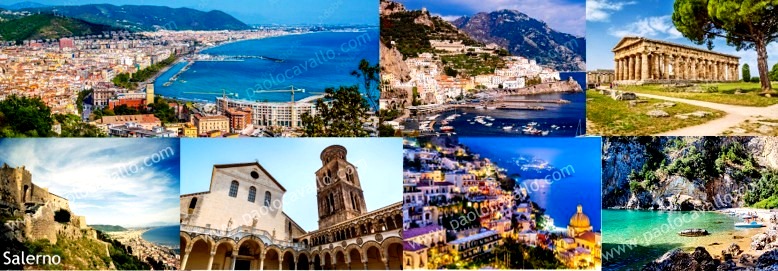
Paolo Cavallo, MPharm, MSc, PGCert, MRPharmS
Clinical Pharmacist (Independent Prescriber)

Paolo Cavallo, MPharm, MSc, PGCert, MRPharmS
Clinical Pharmacist (Independent Prescriber)
Tracing the Roots
Tracing the Roots: The Medical School of Salerno

Hailing from the
vibrant city of Salerno, capital of one of the biggest provinces
of Italy, stretching from the stunning Amalfi Coast to the
pristine Cilento Coast, overlooking the majestic Gulf of Salerno in
South-Western Italy, Paolo's personal and professional journey
has been deeply shaped by this unique locale. As a dedicated
healthcare professional, Paolo has leveraged his rich cultural
background to provide compassionate and personalised care to his
patients.
Salerno's rich history, distinctive customs, and pulsating
energy have left an indelible mark on his life. The city's
roots stretch back to the 9th and 6th Centuries BC, with the
first signs of human habitation. By the 6th Century BC, the
Etruscans had established a settlement named "Irna", after the
local river Irno, marking an important base for trade with the
South-Western Italian Greek colonies. The Romans, in 197 BC,
founded the Roman Colony of Salernum, which grew around
an initial castrum, the Latin term for "fort".
Fast forward to 1000 AD, Salerno rose to prominence as the
capital of one of the largest Southern Italian princedoms - the
Princedom of Salerno. This period saw Salerno reach its zenith,
earning the Latin moniker "Opulenta Salernum" or "The Lavish
Salerno".
During World War II, Salerno played a pivotal role in "Operation
Avalanche", the Allied invasion of Italy on September 9, 1943.
Shortly after, on February 11, 1944, it became the first Italian
post-fascist Capital, a status it held until August 1944.
Today, Salerno stands as a vibrant centre,
with its local airport (Salerno-Costa d'Amalfi, QSR) poised to
attract an increasing number of visitors to this meritorious
area. The city takes pride in its well-conserved medieval town
centre, which features a distinguished cathedral dedicated to
Saint Matthew the Apostle, housing his relics within its crypt,
an enchanting castle perched on a hill, and traditional Roman
urban design. The seafront promenade, considered one of Europe's
premier, extends nearly 3km in length and 30m in width,
comprising three pedestrian lanes, a bicycle lane, and two outer
vehicular lanes, all bordered by flowerbeds and iconic
palm trees.
Salerno's economy thrives on its significant harbour activity,
and its architecture has been modernised over recent decades
with buildings designed by renowned international architects
such as Oriol Bohigas, Zaha Hadid, Sir David Alan Chipperfield,
Massimiliano Fuksas, and Ricardo Bofill.
Between the 9th and 13th Centuries, Salerno was home to the most
important source of medical knowledge in Western Europe. The
Medical School of Salerno, according to legend, was founded
following a chance meeting between four masters: the Jewish Helinus, the Greek Pontus, the Arab Adela, and the Latin
Salernus. The school preserved the Greek-Latin cultural
tradition, harmoniously blending it with Arab and Jewish
culture. This convergence of cultures led to a unique medical
learning environment, synthesising and comparing different
experiences.
Around 900 AD, due to favourable geographic and other
conditions, many cultural contributions synergised with the
Medical School at Salerno, leading to its recognition as
something akin to the world's first university. In the 11th
century, under the influence of
Alfano I, Archbishop of Salerno,
and Constantine the African, Salerno earned the title of "Town
of Hippocrates" (Hippocratica Civitas or Hippocratica
Urbs). People from all corners of the globe flocked to the "Schola
Salerni", both the sick, in hope of recovery, and students, to
learn the art of medicine. Its fame crossed borders, as
evidenced by Salernitan manuscripts found in many European
libraries and historical accounts.
Emerging from the
esteemed halls of the Ancient Medical School of Salerno, the 'Regimen
Sanitatis Salernitanum' serves as a beacon of the
enduring wisdom of our medical ancestors. This seminal work,
also referred to as the 'Salerno Book of Health,' is a
Latin poem that embodies the tenets of health preservation.
Meticulously crafted by the Salernitan physicians, it was a
bestowed treasure of knowledge dedicated to English royalty,
specifically to Robert of Normandy, the descendant of the
illustrious William the Conqueror.
As per certain legends, the poem was composed for the benefit of
the Duke of Normandy, Robert Curthose. It is said that Robert
II, during the Crusades in the Holy Land, was hit by a poisoned
arrow. Upon his return, he sought the expertise of the doctors
at the Salerno Medical School. This ancient tale narrates the
story of a brave Norman warrior, Robert II Duke of Normandy,
who, after being wounded in battle, was brought to Salerno for
treatment at the renowned Medical School.
Interestingly, Salerno was also home to the most ancient European botanical garden, The Gardens of Minerva. Here, it was possible to cultivate every kind of herb known at the time to treat most illnesses.
Remarkably, female physicians at the School of Salerno played a pivotal role in its advancements. Their contributions included textbooks on anatomy, advocacy for physician certification and training, and groundbreaking investigative thinking. Notably, Trotula de' Ruggiero, the first recorded female faculty member, left an enduring legacy. Their collective impact extended across Europe, shaping the course of medical history.
References
Paolo Cavallo, Maria Chiara Proto, Cataldo Patruno, Antonio Del Sorbo and Maurizio Bifulco.
THE FIRST COSMETIC TREATISE OF HISTORY. A FEMALE POINT OF VIEW.
Int J Cosmet Sci. 2008 Apr; 30(2):79-86.
THYROIDOLOGY IN THE MEDIEVAL MEDICAL SCHOOL OF SALERNO
Thyroid Jan 2007, Vol. 17, No. 1: 39-40
See also
"De Ornatu Mulierum": Unveiling Beauty's Ancient Secrets
Regimen Sanitatis Salernitanum
History, Seminars, Scientific Publications, Volunteers and Honors...
The content provided on this website is for informational purposes only and should not be relied upon for any specific purpose. We disclaim liability for any damages that may occur as a result of using this website. All content on this website is the property of the website owner with all rights reserved. We reserve the right to alter or update the website at any time without notice. Unauthorized copying, selling, or licensing of any part of this website is strictly prohibited. Written consent is required for any use. Thank you for your understanding.
Copyright © Paolo Cavallo 2012 - Present. All rights reserved.